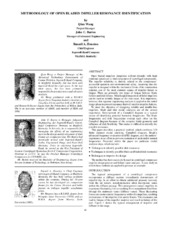| dc.contributor.other | Turbomachinery Symposium (28th : 1999) | |
| dc.creator | Wang, Qian | |
| dc.creator | Bartos, John C. | |
| dc.creator | Houston, Russell A. | |
| dc.date.accessioned | 2017-10-05T14:03:22Z | |
| dc.date.available | 2017-10-05T14:03:22Z | |
| dc.date.issued | 1999 | |
| dc.identifier.uri | https://hdl.handle.net/1969.1/163378 | |
| dc.description | Lecture | en |
| dc.description | Pg. 61-68 | en |
| dc.description.abstract | Open bladed impellers (impellers without shrouds) with high rotational speeds are a vital component of centrifugal compressors. The impeller reliability is directly related to the compressors’ successful operation and environmental safety. Assuming that the impeller is designed within the mechanical limits of its construction material, one of the most common causes of impeller failure is fatigue. There are primarily two types of fatigue failures: blade failures and disk failures. Metallurgical inspection of failed impellers can be used to identify fatigue as the root cause. It is imperative, however, that rigorous engineering analysis is applied in the initial design phase to prevent resonance that will result in impeller failures. To meet the objective of designing reliable and trouble-free impellers, blade and disk modal analyses are of the utmost importance. Development of a Campbell diagram is a typical means of identifying potential harmonic frequencies. The blade frequencies and disk frequencies overlap each other on the Campbell diagram because of the complex blade geometry and influence of disk flexibility. This makes it difficult to identify the possible resonance. This paper describes a practical method, which combines 3-D finite element modal analysis, Campbell diagram, Singh’s advanced frequency evaluation (SAFE) diagram, and the authors’ experience in an effort to prevent excitation of undesirable natural frequencies. Presented within the paper are particular modal analysis steps, which include:
• Techniques to identify possible disk resonance
• Techniques to identify possible blade and bladed disk resonance
• Techniques to improve the design
The method has been successfully used in centrifugal compressor impeller design process and failure cause analyses. A case study in which these methods are applied is given as an example. | en |
| dc.format.medium | Electronic | en |
| dc.format.mimetype | application/pdf | |
| dc.language.iso | en | |
| dc.publisher | Texas A&M University. Turbomachinery Laboratories | |
| dc.relation.ispartof | Proceedings of the 28th Turbomachinery Symposium | en |
| dc.subject.lcsh | Turbomachines | en |
| dc.title | Methodology Of Open Bladed Impeller Resonance Indentification. | en |
| dc.type.genre | Presentation | en |
| dc.type.material | Text | en |
| dc.identifier.doi | https://doi.org/10.21423/R13W9K | |


